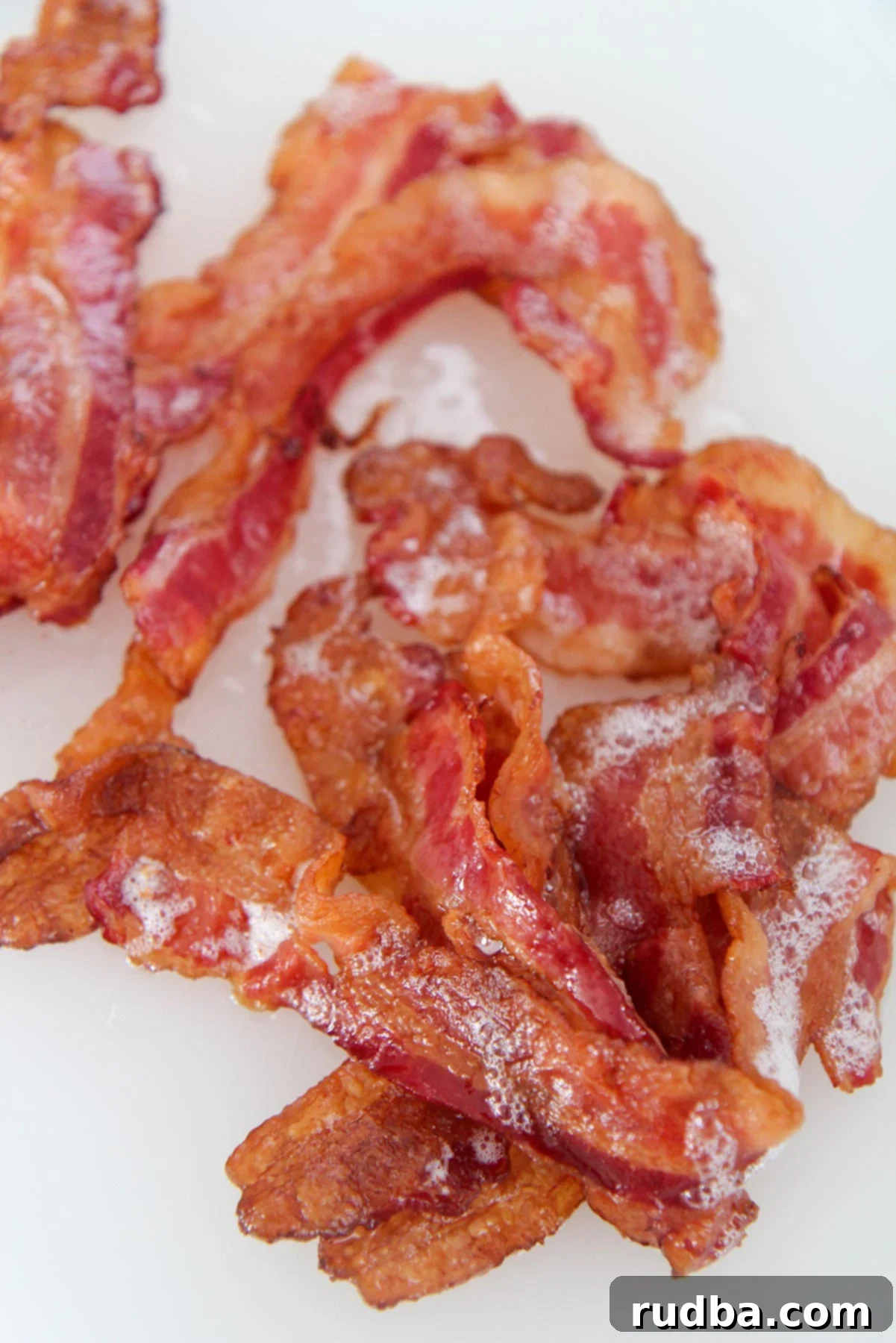Perfect Crispy Bacon Every Time: The Ultimate Guide to Oven Baking Bacon
Tired of standing over a hot skillet, flipping just a few pieces of bacon at a time? Imagine a world where your bacon cooks itself, perfectly crispy and with minimal mess, while you focus on other breakfast or dinner preparations. This isn’t a dream – it’s the reality of oven-baked bacon! Learning how to bake bacon in the oven will revolutionize your cooking routine, cutting your prep time significantly and delivering consistently delicious results.
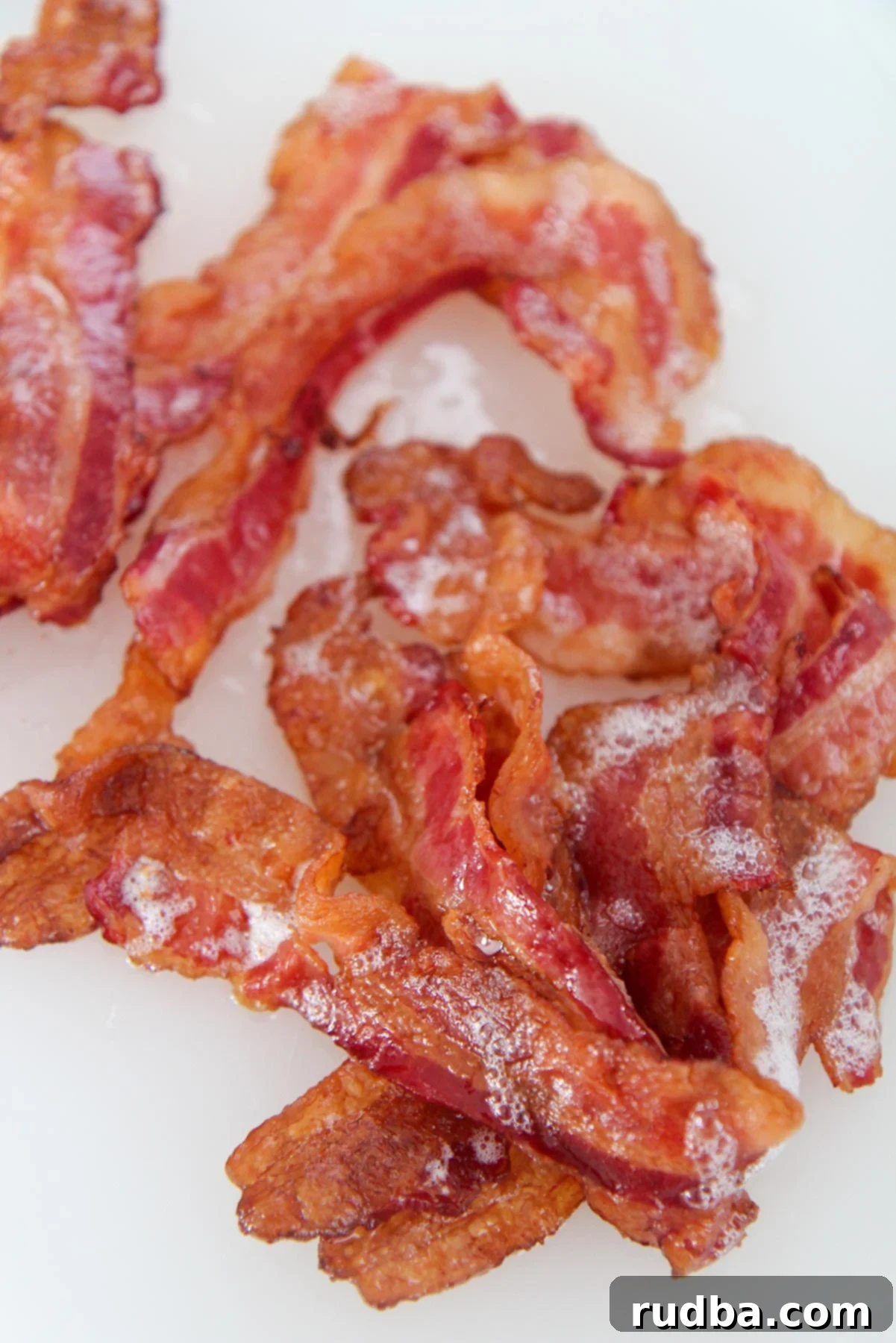
Bacon is a beloved ingredient in countless dishes, and once you master oven baking, you’ll find yourself incorporating it even more often. Some of my absolute favorite recipes feature this savory staple. For instance, Bacon and Corn Pancakes offer a delightful sweet and savory combination that’s truly irresistible. Another personal favorite is Creamy Chicken and Bacon Pasta, which elevates a simple weeknight meal into something special.
Despite bacon’s popularity, it’s surprising how many people aren’t aware of the oven-baking method. For many, the idea of cooking bacon anywhere but a skillet seems entirely new. This is understandable, as most of us grew up watching our parents or grandparents fry bacon on the stovetop. While pan-frying delivers tasty bacon, it’s often a labor-intensive process, requiring constant attention and resulting in greasy splatters all over your kitchen.
The traditional pan-frying method can feel like an endless task, as you’re limited to cooking just a few strips at a time. This becomes particularly frustrating when you’re preparing a large breakfast for the family or need a substantial amount of bacon for a recipe. If there’s a way to achieve perfectly crispy bacon without the constant supervision and significant cleanup, why wouldn’t we embrace it?
Why Oven-Baked Bacon is a Game Changer
Switching from pan-frying to oven baking bacon offers a host of benefits that will make your life easier and your bacon more delicious:
- Hands-Free Cooking: Once the bacon is in the oven, you’re free to prepare other parts of your meal, set the table, or simply relax. No more standing guard at the stove.
- Less Mess: Baking bacon significantly reduces grease splatters. The fat renders and collects on the baking sheet, making cleanup much simpler.
- Consistent Crispy Results: The even heat of the oven cooks bacon more uniformly than a stovetop, leading to consistently crispy strips from end to end.
- Batch Cooking: You can cook a whole pound (or more!) of bacon at once, perfect for feeding a crowd or for meal prepping for the week ahead.
- Customizable Crispness: Whether you prefer slightly chewy or extra-crispy bacon, the oven allows for precise control over your desired texture.
How To Bake Bacon In The Oven: Choosing Your Method
There isn’t just one way to bake bacon in the oven; your preferred texture will often dictate which method you choose. Each option offers slightly different results and cleanup advantages.
- Foil-Lined Baking Sheet – This method yields bacon that’s crispy around the edges with a satisfyingly chewy center. The foil makes for incredibly easy cleanup, as you can simply discard it along with the rendered fat. It’s a great option for those who enjoy a bit of chewiness in their bacon.
- Wire Rack Over Foil-Lined Baking Sheet – For bacon that is extra crispy and less greasy, a wire rack is your best friend. The rack elevates the bacon, allowing the fat to drip away into the foil-lined pan below. This results in incredibly crispy, uniform slices with no chewiness, and cleanup remains simple thanks to the foil.
- Parchment Paper-Lined Baking Sheet – This is personally my favorite method for achieving super crispy bacon that cooks quickly in its own rendered fat. The parchment paper prevents sticking and helps contain the grease, simplifying the cleanup process. The bacon essentially fries in its own rendered fat on the parchment, resulting in a distinct crispness.
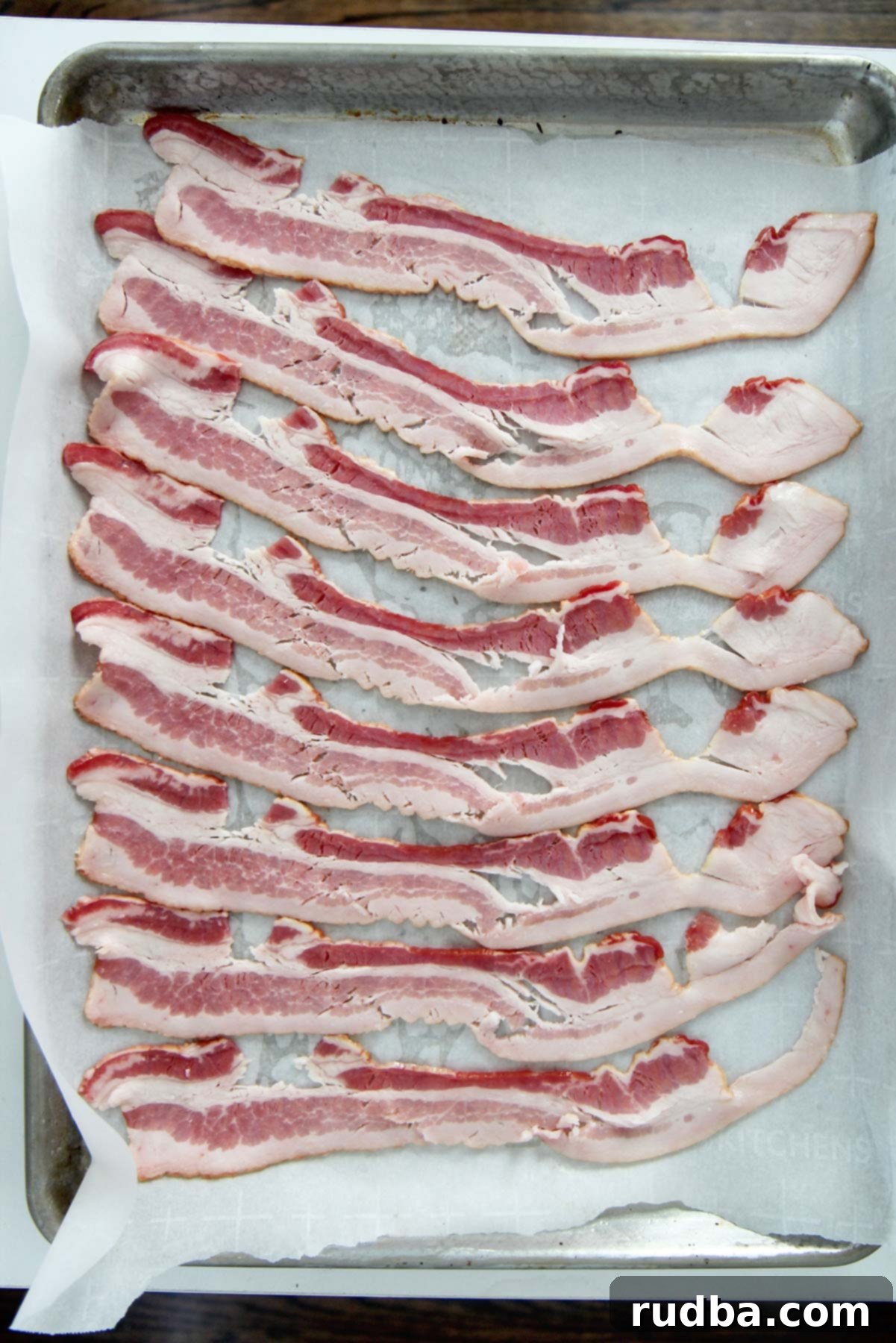
Step-by-Step Guide to Baking Perfect Bacon
No matter which lining method you choose, the basic steps for achieving perfectly baked bacon are simple and consistent. Follow these easy instructions for a flawless result every time.
- Prep Your Oven and Pan – Begin by preheating your oven to 400 degrees Fahrenheit (200 degrees Celsius). While the oven heats, line a standard baking sheet with your chosen material: aluminum foil, a wire rack placed over foil, or parchment paper. Arrange the bacon slices in a single layer, side by side, allowing them to touch slightly. Avoid overcrowding the pan, as this can lead to uneven cooking and less crispiness.
- Bake to Your Desired Crispness – Carefully place the baking sheet with the bacon into the preheated oven. Bake for approximately 15 minutes. This timing typically yields perfectly crispy bacon for standard-cut slices. However, cooking times can vary based on your oven, the thickness of your bacon, and your personal preference. Keep an eye on it after 14 minutes to ensure it reaches your ideal level of crispness.
- Drain Excess Fat – Once the bacon reaches your desired crispiness, carefully remove the baking sheet from the oven. Using tongs, transfer the cooked bacon to a plate or platter lined with several layers of paper towels. This step is crucial for absorbing any excess grease, making your bacon even crisper and less oily. Allow the bacon to drain and cool for a few minutes.
- Serve and Savor – After draining for a few minutes, the bacon will be cool enough to handle and enjoy. Serve it immediately as part of a hearty breakfast, crumbled over salads, tucked into a burger, or as a flavorful addition to sandwiches. The possibilities are endless, and the perfectly baked bacon will enhance any dish!
Top Tips and Delicious Variations
Elevate your oven-baked bacon game with these expert tips and creative variations:
- Adjust Baking Time for Different Bacon Types – Bacon isn’t one-size-fits-all! Thicker-cut bacon will naturally require more time to cook through and become crispy, potentially needing 18-20 minutes or even longer. For thinner bacon, start checking around 12-14 minutes, as it will cook much faster. Always monitor your bacon closely in the last few minutes of cooking to achieve your preferred level of crispness. If you prefer a chewier texture, simply cook it for a shorter duration.
- Always Preheat Your Oven – This is a golden rule for almost any baking endeavor, and bacon is no exception. Placing bacon into a cold oven means it will slowly heat up, leading to uneven cooking and potentially rubbery results. A properly preheated oven ensures the bacon starts cooking immediately and crisps up evenly.
- Save the Bacon Grease – Don’t toss that flavorful rendered fat! Once cooled, strain the bacon grease into a heat-proof jar or container and store it in the refrigerator. This liquid gold is perfect for adding incredible depth of flavor to future recipes. Use it to sauté onions and garlic, fry eggs, roast vegetables, or even make a savory gravy.
- Make Candied Bacon – For a sweet and savory treat, transform your oven-baked bacon into candied bacon. Before baking, simply sprinkle brown sugar evenly over the bacon strips. For an extra touch, you can also drizzle a little maple syrup. The sugar caramelizes as it bakes, creating a sticky, crispy, and utterly addictive result that’s fantastic on its own or as a garnish for desserts and cocktails. A pinch of black pepper can also add a delightful counterpoint to the sweetness.
- Experiment with Seasonings: Beyond candied bacon, try adding other seasonings before baking. A sprinkle of cayenne pepper for a spicy kick, garlic powder for an umami boost, or even a dry rub blend can take your bacon to the next level.
- Meal Prep Perfection: Oven-baked bacon is excellent for meal prepping. Cook a large batch on the weekend, store it in an airtight container in the fridge, and enjoy quick additions to salads, sandwiches, or egg dishes throughout the week. Reheat gently in a microwave or a warm oven for a few minutes.
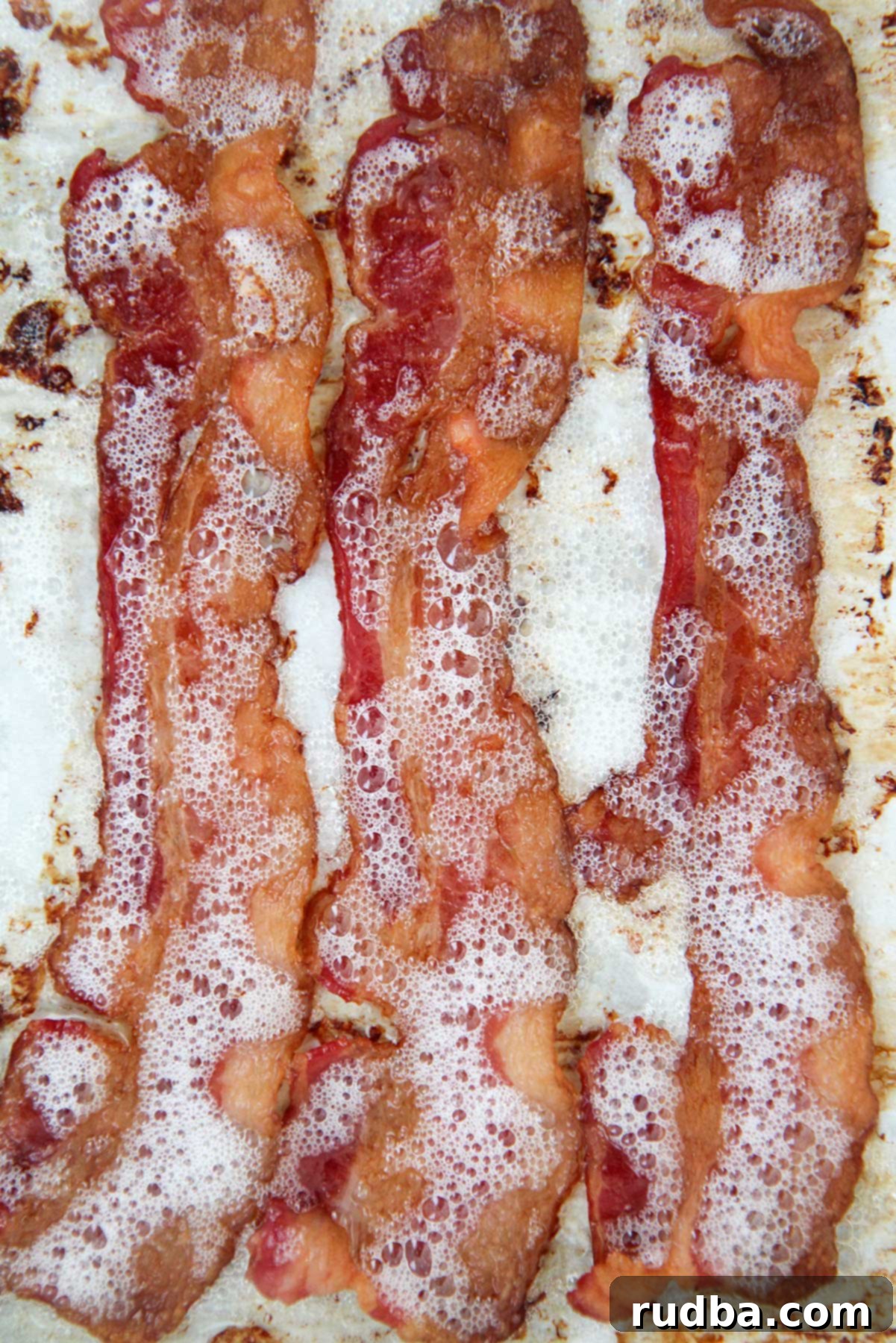
What Temperature Should Bacon Be Cooked To?
When cooking any meat, food safety is paramount. For bacon, the USDA recommends that it reaches an internal temperature of at least 145 degrees Fahrenheit (63 degrees Celsius). Furthermore, it’s advised to let the bacon rest for three minutes after cooking before consuming. While many of us, myself included, have probably eaten bacon straight off the pan without adhering strictly to the resting time – whoops! – following the recommended baking directions above will ensure your bacon is perfectly safe and delicious to consume. The high oven temperature and sufficient cooking time typically guarantee that the bacon reaches and surpasses this safe internal temperature.
A Sizzling History of Bacon
Did you know that bacon boasts a remarkably rich history, tracing its origins back as far as 1500 B.C.? This beloved food item has been a part of human diets for millennia. The ancient Romans, for instance, had their own version of bacon, which they called “petaso.” This early recipe, a predecessor to the bacon we enjoy today, was eventually carried across the world, evolving with different cultures and culinary traditions.
Throughout history, bacon has been prepared in a myriad of ways. While today frying is perhaps the most iconic method, earlier civilizations often boiled their bacon. Imagine a large pot of boiling pork belly, slowly rendering its fat and becoming tender! This historical insight shows just how versatile and enduring bacon has been. Over centuries, various preparation methods emerged, but frying eventually gained widespread popularity due to its speed and ability to create a crispy texture.
As someone who grew up with and loves fried bacon, discovering that baked bacon was just as, if not more, delicious was a delightful surprise. It’s a testament to bacon’s enduring appeal that it can be adapted to modern, more convenient cooking methods without sacrificing its incredible flavor or texture.
Serving Suggestions for Oven-Baked Bacon
The versatility of perfectly oven-baked bacon goes far beyond a traditional breakfast plate. While it’s certainly a star alongside eggs, pancakes, or waffles, don’t limit its potential! Crumbled crispy bacon makes an excellent topping for salads, adding a salty crunch to fresh greens. It’s a game-changer when added to a classic BLT sandwich or layered into a gourmet burger. For dinner, mix it into pasta dishes, stir-fries, or even use it to wrap around asparagus or dates for an elegant appetizer. The rich, savory flavor of bacon truly enhances almost any meal, making it an indispensable ingredient in your kitchen.
For more delicious recipes and cooking tutorial videos, make sure to visit my channels on Youtube and Facebook. Happy cooking!
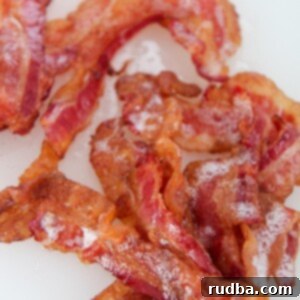
How to Bake Bacon in the Oven
Save RecipeSaved Recipe
Pin Recipe
Rate Recipe
Print Recipe
Equipment
-
baking sheet
-
Parchment Paper
Ingredients
- 1 lb Bacon
Instructions
-
Preheat oven to 400 degrees F.
-
Line a baking sheet with parchment paper. Place the bacon on the baking sheet and bake for 15 minutes or until crispy.
Nutrition
Nutrition information is automatically calculated, so should only be used as an approximation.
Additional Info
Like this recipe? Leave a comment below!
